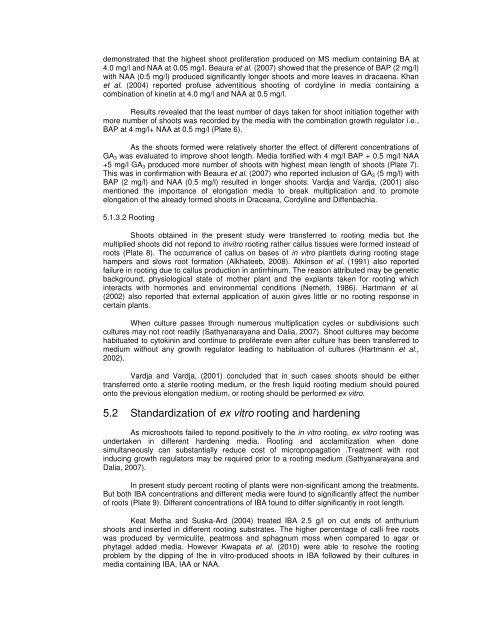micropropagation studies in dracaena and cordyline - ETD ...
micropropagation studies in dracaena and cordyline - ETD ...
micropropagation studies in dracaena and cordyline - ETD ...
You also want an ePaper? Increase the reach of your titles
YUMPU automatically turns print PDFs into web optimized ePapers that Google loves.
demonstrated that the highest shoot proliferation produced on MS medium conta<strong>in</strong><strong>in</strong>g BA at<br />
4.0 mg/l <strong>and</strong> NAA at 0.05 mg/l. Beaura et al. (2007) showed that the presence of BAP (2 mg/l)<br />
with NAA (0.5 mg/l) produced significantly longer shoots <strong>and</strong> more leaves <strong>in</strong> <strong>dracaena</strong>. Khan<br />
et al. (2004) reported profuse adventitious shoot<strong>in</strong>g of cordyl<strong>in</strong>e <strong>in</strong> media conta<strong>in</strong><strong>in</strong>g a<br />
comb<strong>in</strong>ation of k<strong>in</strong>et<strong>in</strong> at 4.0 mg/l <strong>and</strong> NAA at 0.5 mg/l.<br />
Results revealed that the least number of days taken for shoot <strong>in</strong>itiation together with<br />
more number of shoots was recorded by the media with the comb<strong>in</strong>ation growth regulator i.e.,<br />
BAP at 4 mg/l+ NAA at 0.5 mg/l (Plate 6).<br />
As the shoots formed were relatively shorter the effect of different concentrations of<br />
GA3 was evaluated to improve shoot length. Media fortified with 4 mg/l BAP + 0.5 mg/l NAA<br />
+5 mg/l GA3 produced more number of shoots with highest mean length of shoots (Plate 7).<br />
This was <strong>in</strong> confirmation with Beaura et al. (2007) who reported <strong>in</strong>clusion of GA3 (5 mg/l) with<br />
BAP (2 mg/l) <strong>and</strong> NAA (0.5 mg/l) resulted <strong>in</strong> longer shoots. Vardja <strong>and</strong> Vardja, (2001) also<br />
mentioned the importance of elongation media to break multiplication <strong>and</strong> to promote<br />
elongation of the already formed shoots <strong>in</strong> Draceana, Cordyl<strong>in</strong>e <strong>and</strong> Diffenbachia.<br />
5.1.3.2 Root<strong>in</strong>g<br />
Shoots obta<strong>in</strong>ed <strong>in</strong> the present study were transferred to root<strong>in</strong>g media but the<br />
multiplied shoots did not repond to <strong>in</strong>vitro root<strong>in</strong>g rather callus tissues were formed <strong>in</strong>stead of<br />
roots (Plate 8). The occurrence of callus on bases of <strong>in</strong> vitro plantlets dur<strong>in</strong>g root<strong>in</strong>g stage<br />
hampers <strong>and</strong> slows root formation (Alkhateeb, 2008). Atk<strong>in</strong>son et al. (1991) also reported<br />
failure <strong>in</strong> root<strong>in</strong>g due to callus production <strong>in</strong> antirrh<strong>in</strong>um. The reason attributed may be genetic<br />
background, physiological state of mother plant <strong>and</strong> the explants taken for root<strong>in</strong>g which<br />
<strong>in</strong>teracts with hormones <strong>and</strong> environmental conditions (Nemeth, 1986). Hartmann et al.<br />
(2002) also reported that external application of aux<strong>in</strong> gives little or no root<strong>in</strong>g response <strong>in</strong><br />
certa<strong>in</strong> plants.<br />
When culture passes through numerous multiplication cycles or subdivisions such<br />
cultures may not root readily (Sathyanarayana <strong>and</strong> Dalia, 2007). Shoot cultures may become<br />
habituated to cytok<strong>in</strong><strong>in</strong> <strong>and</strong> cont<strong>in</strong>ue to proliferate even after culture has been transferred to<br />
medium without any growth regulator lead<strong>in</strong>g to habituation of cultures (Hartmann et al.,<br />
2002).<br />
Vardja <strong>and</strong> Vardja, (2001) concluded that <strong>in</strong> such cases shoots should be either<br />
transferred onto a sterile root<strong>in</strong>g medium, or the fresh liquid root<strong>in</strong>g medium should poured<br />
onto the previous elongation medium, or root<strong>in</strong>g should be performed ex vitro.<br />
5.2 St<strong>and</strong>ardization of ex vitro root<strong>in</strong>g <strong>and</strong> harden<strong>in</strong>g<br />
As microshoots failed to repond positively to the <strong>in</strong> vitro root<strong>in</strong>g, ex vitro root<strong>in</strong>g was<br />
undertaken <strong>in</strong> different harden<strong>in</strong>g media. Root<strong>in</strong>g <strong>and</strong> acclamitization when done<br />
simultaneously can substantially reduce cost of <strong>micropropagation</strong> .Treatment with root<br />
<strong>in</strong>duc<strong>in</strong>g growth regulators may be required prior to a root<strong>in</strong>g medium (Sathyanarayana <strong>and</strong><br />
Dalia, 2007).<br />
In present study percent root<strong>in</strong>g of plants were non-significant among the treatments.<br />
But both IBA concentrations <strong>and</strong> different media were found to significantly affect the number<br />
of roots (Plate 9). Different concentrations of IBA found to differ significantly <strong>in</strong> root length.<br />
Keat Metha <strong>and</strong> Suska-Ard (2004) treated IBA 2.5 g/l on cut ends of anthurium<br />
shoots <strong>and</strong> <strong>in</strong>serted <strong>in</strong> different root<strong>in</strong>g substrates. The higher percentage of calli free roots<br />
was produced by vermiculite, peatmoss <strong>and</strong> sphagnum moss when compared to agar or<br />
phytagel added media. However Kwapata et al. (2010) were able to resolve the root<strong>in</strong>g<br />
problem by the dipp<strong>in</strong>g of the <strong>in</strong> vitro-produced shoots <strong>in</strong> IBA followed by their cultures <strong>in</strong><br />
media conta<strong>in</strong><strong>in</strong>g IBA, IAA or NAA.

















